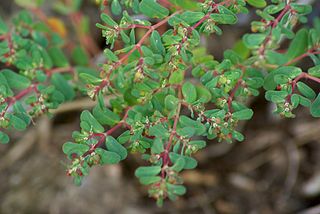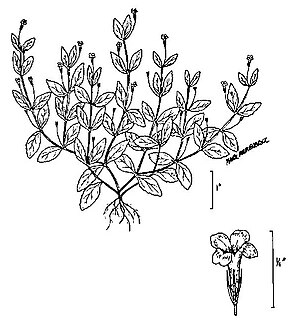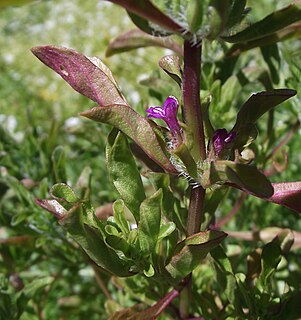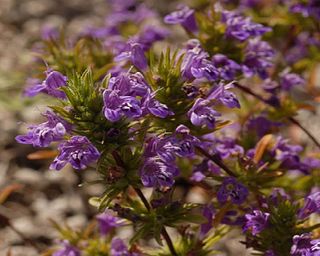
Nymphaea lotus, the white Egyptian lotus, tiger lotus, white lotus or Egyptian white water-lily, is a flowering plant of the family Nymphaeaceae.

Arisaema triphyllum, the jack-in-the-pulpit, bog onion, brown dragon or Indian turnip, is a herbaceous perennial plant growing from a corm. It is a highly variable species typically growing 30–65 centimetres (12–26 in) in height with three-part leaves and flowers contained in a spadix that is covered by a hood. It is native to eastern North America, occurring in moist woodlands and thickets from Nova Scotia west to Minnesota, and south to southern Florida and Texas.

Pogogyne is a small genus of flowering plants in the mint family known generally as mesamints or mesa mints. They are native to Oregon, Idaho, California, and Baja California.

Dodecatheon alpinum is a perennial plant in the primrose family, Primulaceae, known by the common name alpine shooting star.

Veronica serpyllifolia, the thyme-leaved speedwell or thymeleaf speedwell, is a perennial flowering plant in the plantain family. It can be found on most continents.
Lepechinia ganderi is a rare species of flowering plant in the mint family known by the common name San Diego pitcher sage. It is known from only a few populations in northern Baja California and southern San Diego County, California, where it grows in the chaparral of the Peninsular Ranges.

Euphorbia serpyllifolia is a species of euphorb known by the common names thymeleaf sandmat or thyme-leafed spurge. It is native to a large part of North America from Canada to Mexico, where it is a common member of the flora in many types of habitat. This is an annual herb growing as a prostrate mat or taking a somewhat erect form. The oblong leaves are up to about 1.5 centimeters long, sometimes hairy and finely toothed along the edges. The tiny inflorescence is a cyathium about a millimeter wide. It bears scalloped white petal-like appendages arranged around the actual flowers. At the center are several male flowers and one female flower, which develops into a lobed, oval fruit up to 2 millimeters wide. This plant had a number of traditional medicinal uses for many Native American groups.

Collinsia tinctoria is a species of flowering plant in the family Plantaginaceae known by the common names sticky Chinese houses and tincture plant.

Lindernia dubia is a species of flowering plant known by the common names yellowseed false pimpernel and moist bank pimpernel. It is a member of the "new" plant family Linderniaceae, and it is sometimes treated as a member of the families Scrophulariaceae and Plantaginaceae. It is native to much of the Americas from Canada to Chile, and it can be found on other continents as an introduced species. It grows in wet habitat, such as riverbanks, pond margins, and meadows. It is an annual herb growing a mostly erect, branching stem to exceed 30 centimeters in height. The oppositely arranged leaves vary in size and shape, from lance-shaped to oval, toothed or not, and under one to over three centimeters long. Flowers emerge from upper leaf axils. Each has a calyx of five narrow, linear sepals. The tubular corolla is up to a centimeter long, white in color with a blue or purple tint, and lipped at the mouth, the lower lip with three rounded lobes. The fruit is a capsule containing yellow seeds.

Lythrum californicum is a species of flowering plant in the loosestrife family known by the common name California loosestrife. It is native to northern Mexico and the southwestern United States into the Midwest as far east as Oklahoma and Texas. It often grows in moist habitat. This is an erect perennial herb reaching 20 to 60 cm tall, sometimes branching. The waxy linear to lance-shaped leaves are arranged oppositely lower on the plant, and alternately toward the top. They are 1 to 7 cm in length. The inflorescence is a terminal spike of flowers with purple petals under a centimeter long. Flowers are heterostylous on one individual plant, with some having long, protruding styles and some with shorter styles not protruding from the mouth of the flower. The fruit is an oval capsule containing many minute seeds.

Diplacus jepsonii, formerly classified as Mimulus nanus var. jepsonii, is a species of monkeyflower known by the common name Jepson's monkeyflower.
Monardella macrantha is a species of flowering plant in the mint family known by the common name red monardella. It is native to coastal mountain ranges of southern California and Baja California, where it grows in several habitat types, including chaparral, woodlands, and forest.

Pogogyne douglasii is a species of flowering plant in the mint family known by the common names Douglas' mesamint and Douglas' beardstyle.

Pogogyne nudiuscula is a rare species of flowering plant in the mint family known by the common name Otay mesa mint. It is native to southern San Diego County, California, where it is known only from Otay Mesa near the border with Baja California. It was identified on land south of the Mexican border, but these occurrences have probably been extirpated. It is now known from seven vernal pool complexes just north of the border, and it is a federally listed endangered species of the United States.
Pogogyne zizyphoroides is a species of flowering plant in the mint family known by the common names Sacramento mesamint and Sacramento beardstyle.

Silene lemmonii is a species of flowering plant in the family Caryophyllaceae known by the common name Lemmon's catchfly.

Symphoricarpos albus is a species of flowering plant in the honeysuckle family known by the common name common snowberry. It is native to North America, where it occurs across much of Canada and the northern and western United States.

Nothoscordum bivalve is a species of flowering plant in the Amaryllidaceae known by the common names crowpoison and false garlic. It is native to the southern United States from Arizona to Virginia, as well as Mexico, Peru, Uruguay, northeastern Argentina and central Chile.

Eriogonum thymoides is an "abundant" species of flowering plant in the buckwheat family known by the common name thymeleaf wild buckwheat, or simply thymeleaf buckwheat.

Houstonia serpyllifolia, commonly called thymeleaf bluet, is a species of plant in the coffee family (Rubiaceae). It is native to the eastern United States, where it is found in the central and southern Appalachian Mountains. It has been documented in the states of Pennsylvania, Maryland, West Virginia, western Virginia, North Carolina, South Carolina, Kentucky, Tennessee, Ohio, and northeastern Georgia.

















